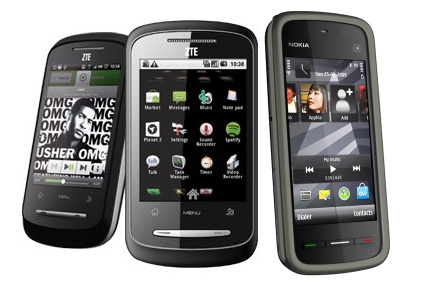One of the long term goals of the Symbian ecosystem was to get handsets into as many hands as possible – and that didn’t mean getting everyone to go for the flagship devices. It meant getting the cost down to the magic mark of £100 in the UK (and a similar-ish $100 or 100 euros, depending on the market). And that’s for a handset that you can walk into a shop, hand over the cash, buy and walk out with the device, with no ongoing contract.
At the tail end of 2009, Nokia shipped the 5230. A candy-bar touch screen 5th Edition device that many viewed as a cut down 5800 XpressMusic went on to sell in significant numbers. That should never have been in any doubt – it has a huge amount of functionality in the built in software, and to a lesser extent the third party software available through the Ovi Store.
While the unlocked price is still hovering around the £120 mark, even the small subsidy that goes with a Pay as You Go phone is enough to push the 5230 well under the £100 mark. Does it matter that the specs are very slightly down on what were standard numbers with the N97? The 5230 ‘budget’ specs would have been cutting edge two or three years ago.
As a company, Nokia’s profit and average selling price per handset has been dropping, and many people have taken this as a bad sign. While it’s not desirable, it’s not as deadly serious to the company as some may make out. They key statistic you should be looking at is market share, both in smartphones and the overall handset share. Because while individual quarters may be measured in profit, the long term goal is to be in as many handsets as possible, and to be the dominant system going forward.
That’s why Nokia should be considered the current leader – there’s a long discussion on this from Tomi Ahonen on his Communities Dominate Brands blog. Titled “Understanding Smartphone Market Share” this is a comprehensive look at why the big winner will be the volume and market share winner, and not judged by the profit per handset. Strong comparisons are drawn to the battle of Betamax (which Sony kept as proprietary) and VHS (which JVC happily let other manufacturers use). The volume of sales and the price of the video recorders were the major factors. The place of Apple in that analogy is clear, while both Android and Symbian are fighting over the JVC role.
And now those two contenders meet in the budget battlefield. Android has threatened to go for the low priced handsets, and now ZTE, with Three in the UK, have delivered a £100 Android handset.

Contenders... Ready!
Back in March I gave the 5230 a workout on a trip around the US, getting to know just how powerful the budget smartphone could be. While I’m staying in Edinburgh during August, it is the Edinburgh Fringe, so there is a lot of opportunity to be out for the whole day, relying on just a smartphone for connectivity, organisation and Web 2.0 interactions.
And I now have a ZTE Racer for trial. So how well does Android compare to S60 when you take it out of the high end Galaxys and Droids, and place it in a price limited, budget device? Will the resulting limitations forced onto the system make it a frustrating experience or will they prove to be perfect for the cheaper end of the market? And how may times will I get mistakenly accused of being a fanboi?
Over the rest of this week, I’ll hopefully answer all of these questions, raise more issues, and explore the budget smartphone arena with you all.
-- Ewan Spence, Aug 2010.
